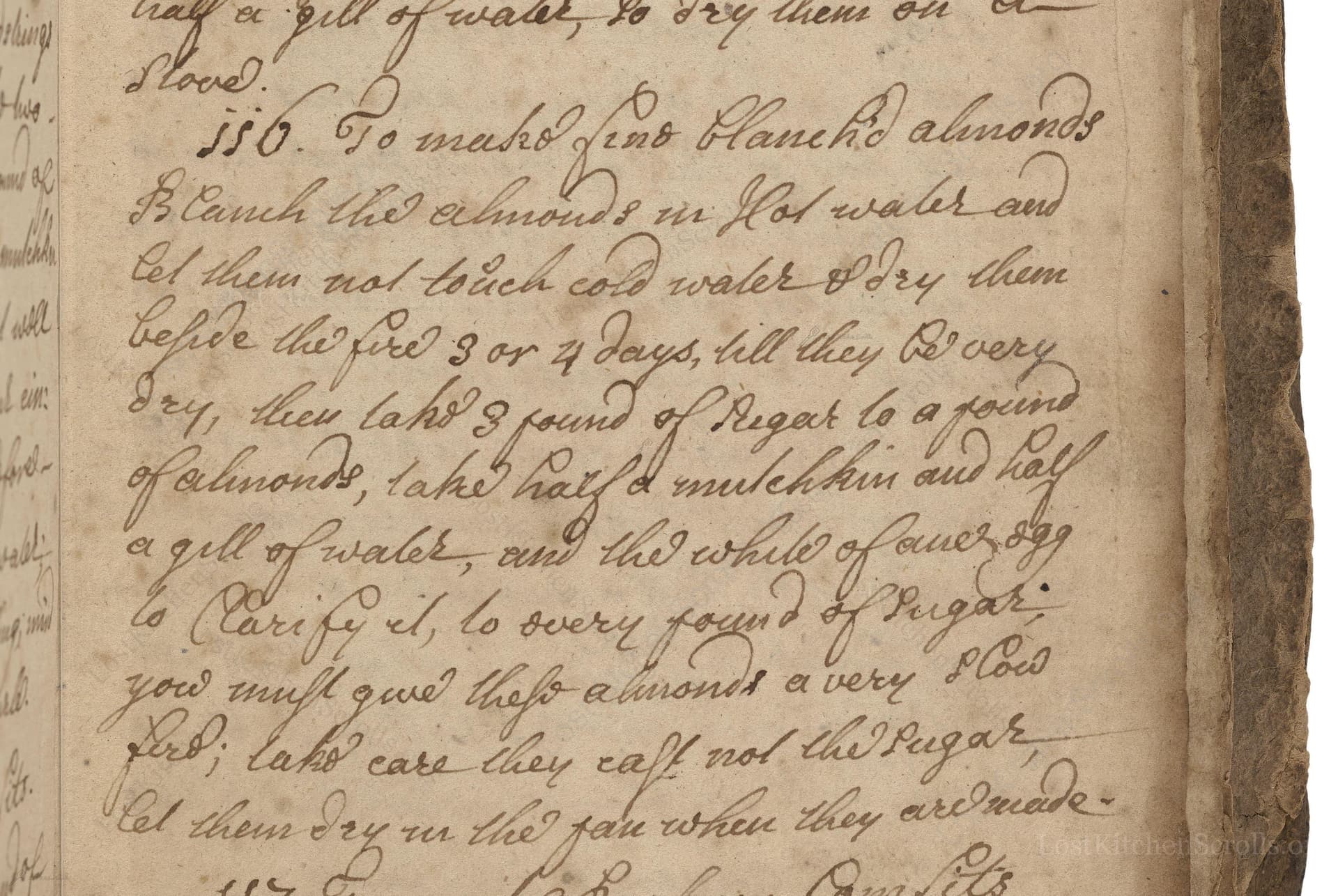To Make Fine Blanched Almonds
From the treasured pages of Receipts for cookery and pastry work
Written by Mrs. Johnston

To Make Fine Blanched Almonds
"Blanch the Almonds in Hot water and let them not touch cold water & Dry them beside the fire 3 or 4 days, till they be very dry, then take 3 pound of Sugar to a pound of almonds, take half a mutchkin and half a gill of water, and the white of one egg to Clarify it, to every pound of Sugar. you must give these almonds a very slow fire; take care they cast not the Sugar, let them dry in the pan when they are made."
Note on the Original Text
Written in a direct, almost conversational style, early modern recipes presume the cook has background knowledge—proportions are given clearly, but timed directions ('very slow fire', 'let them dry') are imprecise by our standards. Terms like 'blanch' and 'clarify' were understood by contemporary readers; 'cast not the sugar' means don't let the syrup crystallize. Historical weights and measures, such as 'mutchkin' and 'gill', need conversion for today's kitchens. Spelling is generally modernized in this recipe, though some period language remains. Careful reading and historical understanding are necessary to interpret the instructions accurately.

Title
Receipts for cookery and pastry work (1700)
You can also click the book image above to peruse the original tome
Writer
Mrs. Johnston
Era
1700
Publisher
Unknown
Background
A delightful compilation of 18th-century recipes gathered by Mrs. Johnston herself, promising a charming journey through the flavors and culinary traditions of the early 1700s.
Kindly made available by
Folger Shakespeare Library
This recipe hails from around 1700, Scotland or England, collected by Mrs. Johnston. Almonds and sugar were prized luxury items, and the careful preparation—blanching, prolonged drying, and clarification—speaks to both the limited kitchen technology of the period and a desire for confectionery refinement. Such sweetmeats were often served at celebratory tables or aimed at impressing guests. Almonds were imported, costly, and handled with great attention, while sugar was still enough of a treasure to merit careful clarification. Recipes like this reveal the evolving sophistication in early modern British home kitchens, as cooks mimicked the elaborate confections of grand households using the tools and ingredients at hand.

The process would have required a brass or copper sugar pan, a ladle for stirring, a fine strainer or cloth for clarifying the syrup, and cloths for drying the almonds. Almonds would be dried beside a hearth or somewhere warm, perhaps near the bread oven or over a shelf above the fire. A wooden spoon for stirring and sheets of waxed or parchment paper for drying the finished almonds would round out the historical toolkit.
Prep Time
PT4D
Cook Time
30 mins
Servings
18
We've done our best to adapt this historical recipe for modern kitchens, but some details may still need refinement. We warmly welcome feedback from fellow cooks and culinary historians — your insights support the entire community!
Ingredients
- 1 lb whole almonds (raw, with skins; blanched as directed)
- 3 lbs granulated sugar
- 18 fl oz water
- 3 egg whites (from large eggs, one per 1 lb sugar)
Instructions
- Begin by blanching 1 lb of almonds in hot water—pour boiling water over them, allow to sit a few minutes, then slip off the skins by hand.
- Instead of plunging the almonds into cold water, dry them thoroughly on a clean cloth, then leave them spread out near a warm spot (such as an oven set to a very low temperature, no higher than 120°F) for 3 to 4 days, or until completely dry.
- For the sugar syrup, use 3 lbs of granulated sugar to 1 lb almonds.
- For every pound sugar, mix 4 fl oz water (half a 'mutchkin') and 2 fl oz water (half a 'gill'), totalling 6 fl oz, and add the white of one egg.
- Bring the sugar and water gently to a boil, add the egg white to clarify the syrup (removing any scum as it appears), then strain the clarified syrup before combining with the dried almonds.
- Coat the dried almonds in the hot syrup over a very gentle heat, turning constantly so they don’t caramelize too quickly or crystallize ('cast their sugar').
- Allow the coated almonds to dry slowly in the warm pan or on parchment until set and glistening.
Estimated Calories
300 per serving
Cooking Estimates
Blanching and drying the almonds takes several days, but the hands-on prep time is much shorter. Cooking time refers to making the syrup and candying the almonds. Each serving is estimated based on typical portion sizes for candied nuts.
As noted above, we have made our best effort to translate and adapt this historical recipe for modern kitchens, taking into account ingredients nowadays, cooking techniques, measurements, and so on. However, historical recipes often contain assumptions that require interpretation.
We'd love for anyone to help improve these adaptations. Community contributions are highly welcome. If you have suggestions, corrections, or cooking tips based on your experience with this recipe, please share them below.
Join the Discussion
Rate This Recipe
Dietary Preference
Main Ingredients

Den Bockfisch In Einer Fleisch Suppen Zu Kochen
This recipe hails from a German manuscript cookbook compiled in 1696, a time whe...

Die Grieß Nudlen Zumachen
This recipe comes from a rather mysterious manuscript cookbook, penned anonymous...

Ein Boudain
This recipe comes from an anonymous German-language manuscript cookbook from 169...

Ein Gesaltzen Citroni
This recipe, dating from 1696, comes from an extensive anonymous German cookbook...
Browse our complete collection of time-honored recipes



